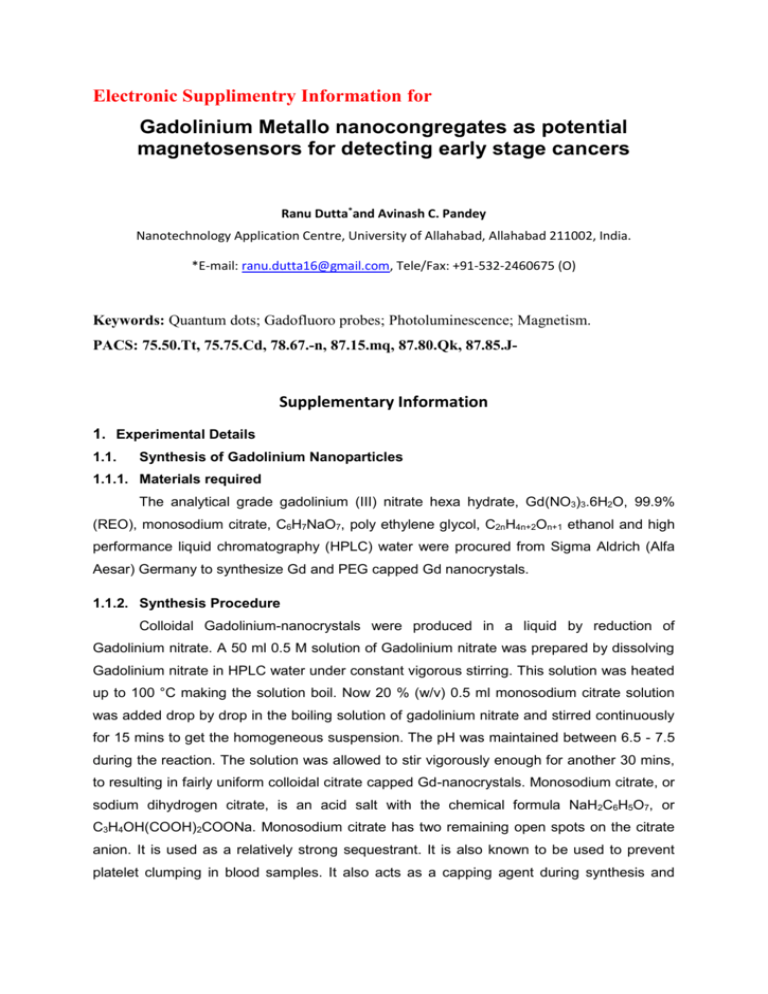Electronic Supplimentry Information for APL_3 April
advertisement

Electronic Supplimentry Information for Gadolinium Metallo nanocongregates as potential magnetosensors for detecting early stage cancers Ranu Dutta*and Avinash C. Pandey Nanotechnology Application Centre, University of Allahabad, Allahabad 211002, India. *E-mail: ranu.dutta16@gmail.com, Tele/Fax: +91-532-2460675 (O) Keywords: Quantum dots; Gadofluoro probes; Photoluminescence; Magnetism. PACS: 75.50.Tt, 75.75.Cd, 78.67.-n, 87.15.mq, 87.80.Qk, 87.85.J- Supplementary Information 1. Experimental Details 1.1. Synthesis of Gadolinium Nanoparticles 1.1.1. Materials required The analytical grade gadolinium (III) nitrate hexa hydrate, Gd(NO3)3.6H2O, 99.9% (REO), monosodium citrate, C6H7NaO7, poly ethylene glycol, C2nH4n+2On+1 ethanol and high performance liquid chromatography (HPLC) water were procured from Sigma Aldrich (Alfa Aesar) Germany to synthesize Gd and PEG capped Gd nanocrystals. 1.1.2. Synthesis Procedure Colloidal Gadolinium-nanocrystals were produced in a liquid by reduction of Gadolinium nitrate. A 50 ml 0.5 M solution of Gadolinium nitrate was prepared by dissolving Gadolinium nitrate in HPLC water under constant vigorous stirring. This solution was heated up to 100 °C making the solution boil. Now 20 % (w/v) 0.5 ml monosodium citrate solution was added drop by drop in the boiling solution of gadolinium nitrate and stirred continuously for 15 mins to get the homogeneous suspension. The pH was maintained between 6.5 - 7.5 during the reaction. The solution was allowed to stir vigorously enough for another 30 mins, to resulting in fairly uniform colloidal citrate capped Gd-nanocrystals. Monosodium citrate, or sodium dihydrogen citrate, is an acid salt with the chemical formula NaH2C6H5O7, or C3H4OH(COOH)2COONa. Monosodium citrate has two remaining open spots on the citrate anion. It is used as a relatively strong sequestrant. It is also known to be used to prevent platelet clumping in blood samples. It also acts as a capping agent during synthesis and controls the growth of nanocrystals. The synthesis process and growth of colloidal citrate capped nanocrystals is pictorially shown in scheme A of Fig. 1. The PEG capped Gd-nanocrystals are produced when Gd-Citrates having carboxylic groups at their surface are mixed with polyethylene glycol (PEG600) and heated at 100 °C in the presence of an acidic environment. 500 l of PEG 600 was used during the reaction. After nearly 2 hrs of vigorous stirring uniform colloidal stable Gd-nanocrystals are formed. The process is shown in scheme B of SI Fig. 1. 1.2. Characterizations Used The prepared Gd nanocrystals were thoroughly characterized by transmission electron microscopy (TEM). The size, morphology and lattice information of prepared nanoparticles were studied using a Tecnai 30 G2 S-Twin high resolution transmission electron microscope (HRTEM) operated at 300 KV accelerating voltage by placing a drop of as synthesized Gd nanocrystals solution on the surface of a carbon coated copper grid. Core level X-ray photoelectron spectroscopy (XPS) studies were carried out using AlK radiation to know the valance state of the Gd-ion. Room temperature magnetization measurement was carried out using a vibrating sample magnetometer (VSM) (ADE Magnetics, USA) up to an applied field of 1.75 T with pressed pellets of prepared powdered samples. The relaxivity measurements were carried out on 14 T Bruker Biospin NMR wide bore (80 mm) spectrometer having microimaging accessories and a 38 mm proton volume resonator. 1.3. MRI Measurements 1.3.1. Acquisition of Bio Images The longitudinal (T1) relaxation times along with bio-imaging studies were carried out at various solutions of different Gd-nanocrystals concentrations. The solutions of the nanoparticles were imaged using a clinical MRI scanner at 3T. The vials containing nanoparticles were placed in a human wrist coil during the scanning process. All data and images were acquired using a 3T Siemens MRI instrument. The recording parameters were, TR (Repetition Time) = 500,700,900,1100,1300,1500 ms TE (Echo Time) = 13 ms, FOV (Field of view) = 40 mm, Matrix Size = 256 X 256, Slice thickness as well as inter-slice thickness = 2mm, NEX (Number of Excitation) = 4. 1.4. In vivo MRI measurements 1.4.1. Animal model For the invivo experiments, female swiss albino balb/c mice, 3-4 weeks old, weighting between 25 and 30 gm were taken. The mice taken for in-vivo studies have weight 25 to 30 gm. For induction of tumors, hair was removed from a small area at the back of each mouse. After which argemone oil was applied tropically (100l) over the cleared skin surface, which acts as a tumor initiator. After 1 week, 4nM 12-O-tetradecanoyl-phorbol-13acetate (TPA) was applied, twice a week. TPA acts as a tumor promoter. Three groups of mice for the MRI imaging studies, namely, Group A - Control Group B - Advanced stage tumor bearing mice (8-10 weeks) Group C - Early stage tumor bearing mice (7-10 days) Skin tumors were induced in a group of mice (Group B) and tumor begins to appear after Tumor appears on skin after 14 weeks. After 8 weeks of induction in group B, skin tumor was induced in a group of mice (Group C). When tumors begin to appear on the second group mice, i.e. group C mice imaging experiments were carried out. Hence the advanced stage tumor induced mice carry cancers which are 8-10 weeks from the time of appearance of the tumor, while early stage tumor induced carry 7-10 days old tumor from the time of appearance. 1.5. MRI measurements The homogeneous suspension of Gd nanocrystals was employed for invivo MRI studies in mice. The mice were induced with skin cancers and imaged before and after injection of Gd nanocrystals suspension. Mice were anesthetized for imaging with the use of a general anaesthesia administrated (intra peritoneal I.P. injection of a mixture of 12 mg/kg xylazine and 80 mg/kg ketamine.). MR imaging was performed with a 3 T imager (GE Sigma Exite Twin-speed, GE Health Care, Milwaukee, WI) using a human wrist coil. Groups of three mice each were used to evaluate contrast enhancement efficacy for the contrast agent. Contrast agent was administered via tail vein at a dose of 0.01 mmol Gd/kg for both standard Gd-DTPA and synthesized Gd nanocrystals suspension. The concentration of the contrast agent taken was ten times less than Gd-DTPA, which were estimated by ICP MS. The mice were placed in a human wrist coil and scanned in a Siemens 3T MRI scanner at preinjection and at 2 min and after 30 min post injection using a fat suppression 3D FLASH sequence (TR ) 7.8 ms, TE ) 2.74 ms, 25° flip angle, 0.5 mm slice thickness). Axial tumor MR images were also acquired using a 2D spin-echo sequence (TR ) 400 ms, TE ) 8.9 ms, 90° flip angle, 2.0 mm slice thickness). Pharmacokinetics studies pertaining to the retention of theses nanoparticles and their distribution were carried out. A series of T1 MR images of various organs such as the skin tumor, heart, kidney and bladder etc. were then taken with at several time intervals, before and after injection of the sample solution. SI Fig. 2, shows very strong paramagnetic nature resulting in a relaxivity (r1) of water proton mM-1S-1. This large r1 could be understood in terms of the huge surface to volume ratio (S/V) of the Gd nanocrystals coupled with the cooperative induction of surface Gd(III) ions for the longitudinal relaxation of a water proton.23 High contrast in-vivo T1 MR Images of a swiss albino mice having early and advanced stage cancer were observed. The present study shows small cancer lesions and even demarcates the spread of the cancer. Furthermore, preliminary pharmacokinetic studies were also carried out to study the fate of the Gd nanocrystals inside the body, its retention and excretion via renal clearance. This approach could address both imaging sensitivity and safety of Gd use. Figure files Scheme A: Scheme B: Fig. S1: (Scheme A): Schematic diagram for Synthesis process and growth of colloidal citrate stabilized nanocongregates. (Scheme B): Formation of colloidal stable PEG modified Gd-nanocongregates from the citrate modified nanocrystals. Fig. S2: Dependence of mass corrected magnetization at room temperature with applied magnetic field (M-H plot) for Gd-nanocrystals.





![Historical_politcal_background_(intro)[1]](http://s2.studylib.net/store/data/005222460_1-479b8dcb7799e13bea2e28f4fa4bf82a-300x300.png)


